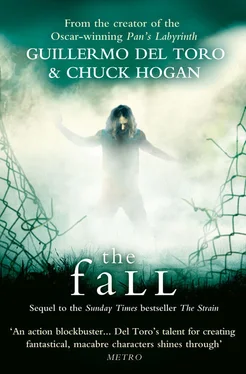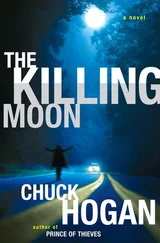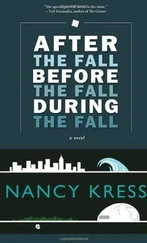His heart was racing again, just thinking of lost opportunities. Fluttering and skipping beats. Lurching. Like an impatient child inside him, wanting to run and run.
Pic—pic—pic …
A low hum purred above the heartbeat.
Setrakian knew it well: this was the prelude to oblivion, to waking up inside an emergency room, if there were any still operating …
With a stiff finger, he fished a white pill out of his box. Nitroglycerin prevented angina by relaxing the vessels carrying blood to his heart, allowing them to dilate, increasing flow and oxygen supply. A sublingual tablet, he placed it underneath his dry tongue, to dissolve.
There was immediately a sweet, tingling sensation. In a few minutes, the murmur in his heart would subside.
The fast-acting nitro pill reassured him. All this second-guessing, this recrimination and mourning: it was a waste of brain activity.
Here he was now. His adopted Manhattan called to him, crumbling from within.
It was a few weeks now since the 777 had touched down at JFK. Since the arrival of the Master and the start of the outbreak. Setrakian had foreseen it from the first news report, as surely as one intuits the death of a loved one when the phone rings at an odd hour. News of the dead plane gripped the city. Just minutes after landing safely, the plane had shut down completely, sitting dark on the taxiway. The Centers for Disease Control and Prevention boarded the plane in contact suits and found all passengers and crew dead, but for four “survivors.” These survivors were not well at all, their disease syndrome only augmented by the Master. Hidden inside his coffin within the cargo hold of the airplane, the Master had been delivered across the ocean thanks to the wealth and influence of Eldritch Palmer: a dying man who had chosen not to die but instead to trade human control of the planet for a taste of eternity. After a day’s incubation, the virus activated in the dead passengers and they arose from their morgue tables and carried the vampiric plague into the city streets.
The full extent of the plague was known to Setrakian, but the rest of the world resisted the horrible truth. Since then, another airplane had shut down soon after landing at London’s Heathrow Airport, stopping dead on the taxiway to the gate. At Orly Airport, an Air France jet arrived stillborn. At Narita International Airport in Tokyo. At Franz Joseph Strauss in Munich. At the famously secure Ben Gurion International in Tel Aviv, where counterterrorist commandos stormed the darkened airliner on the tarmac to find all 126 passengers dead or unresponsive. And yet no alerts were issued to search the cargo areas, or to destroy the airplanes outright. It was happening too fast, and disinformation and disbelief ruled the day.
And on it went. In Madrid. Beijing. Warsaw. Moscow. Brasília. Auckland. Oslo. Sofia. Stockholm. Reykjavik. Jakarta. New Delhi. Certain more militant and paranoid territories had correctly initiated immediate airport quarantines, cordoning off the dead jets with military force, and yet … Setrakian couldn’t help but suspect that these landings were as much a tactical distraction as an attempt at infection. Only time would tell if he was correct—though, in truth, there was precious little time.
By now, the original strigoi —the first generation of vampires, the Regis Air victims, and their Dear Ones—had begun their second wave of maturation. They were becoming more accustomed to their environment and new bodies. Learning to adapt, to survive—to thrive. They attacked at nightfall, the news reported “rioting” in large sectors of the city, and this was partially true—looting and vandalism ran rampant in broad daylight—but no one pointed out that activity spiked at night.
Because of these disruptions occurring nationwide, the country’s infrastructure was beginning to crumble. Food delivery lines were broken, distribution delayed. As absences increased, available manpower suffered and electrical outages and brownouts went unserviced. Police and fire response times were down, and incidences of vigilantism and arson up.
Fires burned. Looters prevailed.
Setrakian stared into his face, wishing he could once again glimpse the younger man within. Perhaps even the boy. He thought of young Zachary Goodweather, just down the hall in the spare bedroom. And, somehow, the old man at the end of his life felt sorry for the boy—eleven years old but already at the end of childhood. Tumbling from grace, stalked by an undead thing occupying the body of his mother …
Setrakian stepped out to the dressing area of his bedroom, finding his way to a chair. He sat with one hand covering his face, waiting for the disorienting sensation to pass.
Great tragedy leads to feelings of isolation, which sought to envelop him now. He mourned his long-lost wife, Miriam. Memories of her face had been crowded out of his mind by the few photographs in his possession, which he referred to often and which had the effect of freezing her image in time without ever truly capturing her being. She had been the love of his life. He was a lucky man; it was a struggle sometimes to remember this. He had courted and married a beautiful woman. He had seen beauty and he had seen evil. He had witnessed the best and the worst of the previous century, and he had survived it all. Now he was witnessing the end.
He thought of Ephraim’s ex-wife, Kelly, whom Setrakian had met once in life and once again in death. He understood the man’s pain. He understood the pain of this world.
Outside, he heard another automobile crash. Gunshots in the distance, alarms ringing insistently—cars, buildings—all going unanswered. The screams that split the night were the last cries of humanity. Looters were taking not only goods and property—they were looting souls. Not taking possessions—but taking possession.
He let his hand fall, landing upon a catalog on the small side table. A Sotheby’s catalog. The auction was to be held in just a few days. This was not a coincidence. None of it was coincidence: not the recent occultation, not the conflict overseas, not the economic recession. Like orderly dominoes we fall.
He lifted the auction catalog and searched for a particular page. In it, without any accompanying illustration, was listed an ancient volume:
Occido Lumen (1667)—A compleat account of the first rise of the Strigoi and full confutation of all arguments produced against their existence, translated by the late Rabbi Avigdor Levy. Private collection. Illuminated manuscript, original binding. In view upon appointment. Estimated $15–$25M
This very book—not a facsimile, not a photograph—was crucial to understanding the enemy, the strigoi. And vanquishing it.
The book was based on a collection of ancient Mesopotamian clay tablets first discovered in jars inside a cave in the Zagros Mountains in 1508. Written in Sumerian and extremely fragile, the tablets were traded to a wealthy silk merchant, who traveled with them throughout Europe. The merchant was found strangled in his quarters in Florence and his warehouses set on fire. The tablets, however, survived in the possession of two necromancers, the famous John Dee and a more obscure acolyte known to history as John Silence. Dee was Queen Elizabeth I’s consultant, and, unable to decipher them, kept the tablets as a magical artifact until 1608 when, forced by poverty, he sold them—through his daughter Katherine—to the learned Rabbi Avigdor Levy in the old ghetto of Metz, in Lorraine, France. For decades, the rabbi meticulously deciphered the tablets, utilizing his unique abilities—it would be almost three centuries before others could finally be able to decipher similar tablets—and eventually presented his findings in manuscript form as a gift for King Louis XIV.
Читать дальше












